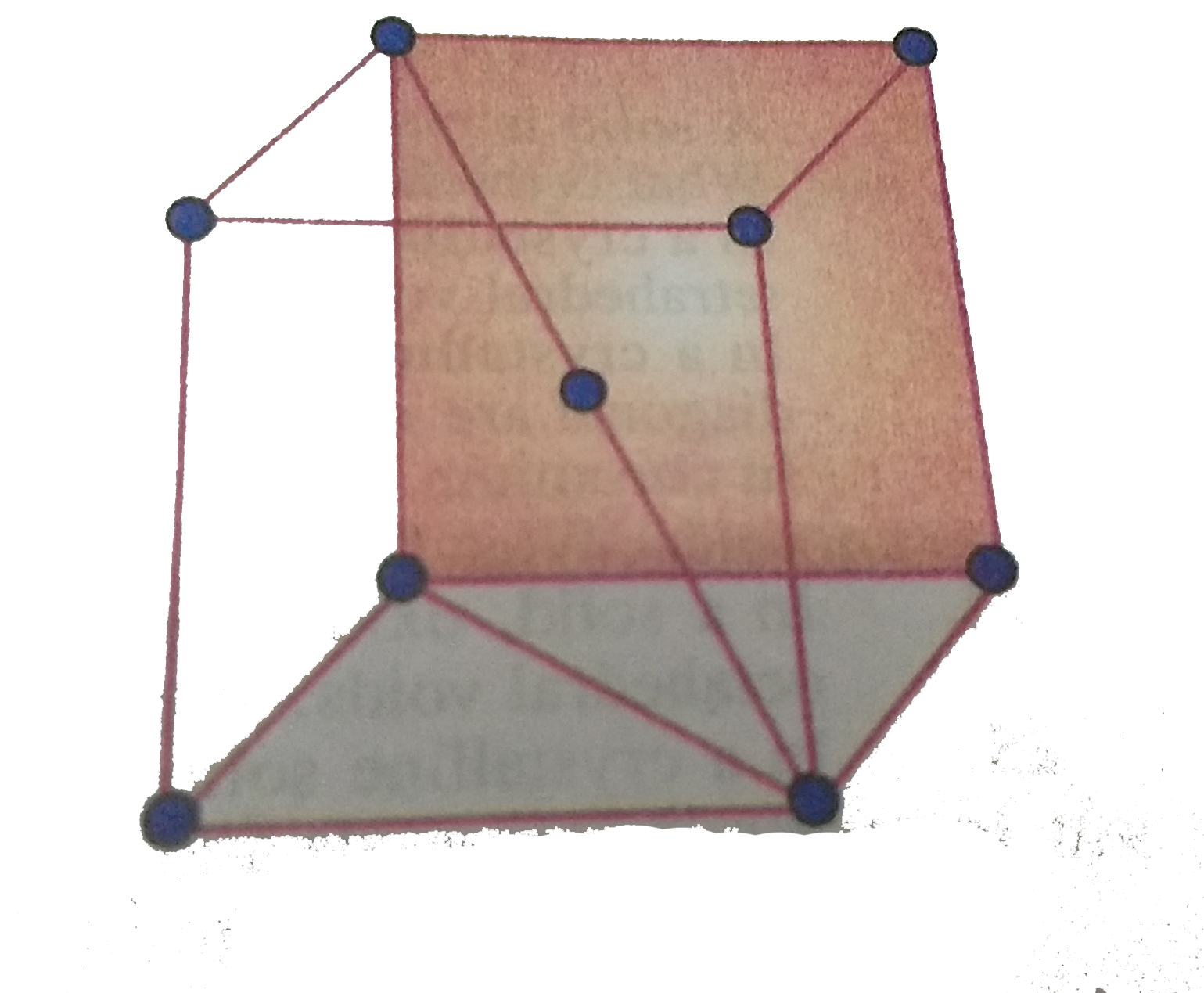Calculate the density (in kg m−3) of potassium having a bcc structure with nearest neighbour distance of 4.52Å. (Given atomic weight of potassium is 39)
The correct Answer is:910
To calculate the density of potassium with a body-centered cubic (BCC) structure and a nearest neighbor distance of 4.52 Å, follow these steps:
Step 1: Understand the BCC Structure
In a BCC unit cell, there are 2 atoms per unit cell. The nearest neighbor distance is the distance between the atom at the center of the cube and the atoms at the corners.
Step 2: Relate Nearest Neighbor Distance to Cube Edge Length
The nearest neighbor distance (d) in a BCC structure is related to the edge length (A) of the cube by the formula:
d=√32A
Given that the nearest neighbor distance is 4.52 Å, we can express this in meters:
d=4.52×10−10 m
Step 3: Solve for the Edge Length (A)
Rearranging the formula to find A:
A=2d√3
Substituting the value of d:
A=2×4.52×10−10√3
Calculating A:
A≈9.04×10−101.732≈5.22×10−10 m
Step 4: Calculate the Volume of the Unit Cell
The volume (V) of the unit cell is given by:
V=A3
Substituting the value of A:
V=(5.22×10−10)3
Calculating V:
V≈1.42×10−28 m3
Step 5: Calculate the Mass of Potassium in the Unit Cell
The mass of one potassium atom can be calculated using its atomic weight (given as 39 g/mol) and Avogadro's number (6.022 × 10²³ mol⁻¹):
Mass of one atom=39 g/mol6.022×1023 mol−1
Converting grams to kilograms:
Mass of one atom≈39×10−36.022×1023≈6.48×10−26 kg
Step 6: Calculate the Total Mass in the Unit Cell
Since there are 2 atoms in a BCC unit cell:
Total mass=2×6.48×10−26 kg≈1.296×10−25 kg
Step 7: Calculate the Density
Density (ρ) is given by the formula:
ρ=Total massVolume
Substituting the values:
ρ=1.296×10−251.42×10−28
Calculating the density:
ρ≈911.27 kg/m3
Final Answer
The density of potassium is approximately 911.27 kg/m³.
---
In a BCC unit cell, there are 2 atoms per unit cell. The nearest neighbor distance is the distance between the atom at the center of the cube and the atoms at the corners.
The nearest neighbor distance (d) in a BCC structure is related to the edge length (A) of the cube by the formula:
d=√32A
Given that the nearest neighbor distance is 4.52 Å, we can express this in meters:
d=4.52×10−10 m
Rearranging the formula to find A:
A=2d√3
Substituting the value of d:
A=2×4.52×10−10√3
Calculating A:
A≈9.04×10−101.732≈5.22×10−10 m
The volume (V) of the unit cell is given by:
V=A3
Substituting the value of A:
V=(5.22×10−10)3
Calculating V:
V≈1.42×10−28 m3
The mass of one potassium atom can be calculated using its atomic weight (given as 39 g/mol) and Avogadro's number (6.022 × 10²³ mol⁻¹):
Mass of one atom=39 g/mol6.022×1023 mol−1
Converting grams to kilograms:
Mass of one atom≈39×10−36.022×1023≈6.48×10−26 kg
Since there are 2 atoms in a BCC unit cell:
Total mass=2×6.48×10−26 kg≈1.296×10−25 kg
Density (ρ) is given by the formula:
ρ=Total massVolume
Substituting the values:
ρ=1.296×10−251.42×10−28
Calculating the density:
ρ≈911.27 kg/m3
The density of potassium is approximately 911.27 kg/m³.
Similar Questions
Potassium has a bcc structure with nearest neighour distance 4.52Åits atomic weight is 39 its density (in kg m−3) will be
View SolutionSodium has a bcc structure with nearest neighbour distance of 365.9 pm. Calculate its density. (Atomic mass of sodium =23)
View SolutionA metal X has a BCC structure with nearest neighbor distance 365.9 pm. What is metal X if its density is 1.0016 g cm−3?
View SolutionA binary salt AB (formula weight = 6.023 Y amu, where Y is an arbitray number) has rock salt structure with 1:1 ratio of A to B. The shortes A - B distance in the unit cell is Y1/3nm.
(a) Calculate the density of the salt in kgm−3
(ii) Given that the measured denstiy of the salt is 20kgm−3, specify the type of point defect present in the crystal
View SolutionPotassium crystallises in a bcc lattice as shown in figure :
(a) What is the distance the nearest neighbours ?
(b) What is the distance between the next nearest neighbours ?
(c) How many nearest neighbours does each potassium atom have ?
(d) How many next nearest neighbours does each potassium atom have ?

View SolutionAn elemental crystal has density of 8570kgm−3. The packing efficiency is 0.68. If the closest distance between neighbouring atoms is 2.86Å. The mass of one atom is (1aμ=1.66×10−27)kg)
View SolutionCsBr has bcc like structures with edge length 4.3Å. The shortest inter ionic distance in between Cs+ and Br− is:
View SolutionWhat is the drift velocity of electrons in a silver wire of length 2 m, having cross-sectional area 6.14×10−6m2 and carrying a current of 5A. Given, atomic weight of silver = 108, density of silver =9.5×103kg/m3, charge of electron =1.6×10−19C, Avogadro's number =6.023×1026 per kmol?
View SolutionA metal crystallizes in a closed packed structure, the atoms stack together occupying maximum space and leaving minimum vacant space. Each sphere in the first layer is in contact with six neighbours. Now while arranging the second layer on the first layer, spheres are placed in depression of first layer. Spheres of third layer lie in the depression of second layer.
This repeating arrangement of atoms produces a giant lattice.
If sphere of third layer do not lie directly over the atoms of first layer, then density of unit cell is,
(Given: atomic weight of metal is 197u and a=4.07Å)
View SolutionLet MgTiO3 exists in pervoskite structure. In this lattice, all the atoms of one of the face diagonals are removed. Calculate the denstiy of unit cell if the radius of Mg2+ is 0.7Å and the corner ions are touching each other. [Given atomic mass of Mg = 24, Ti = 48]
View Solution
